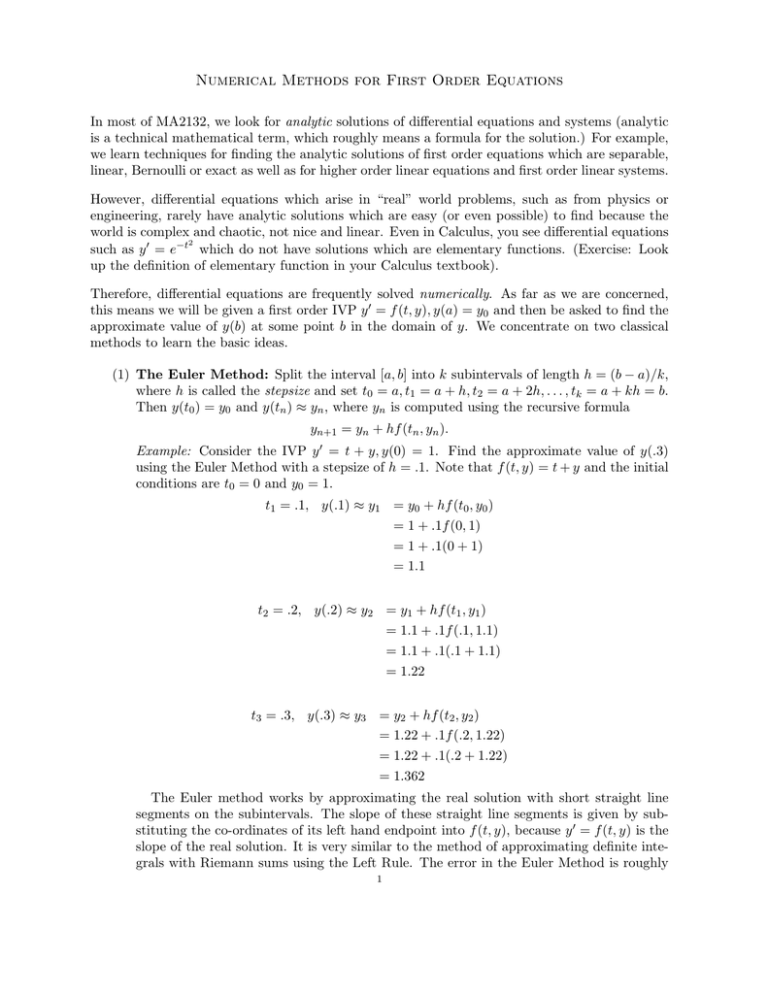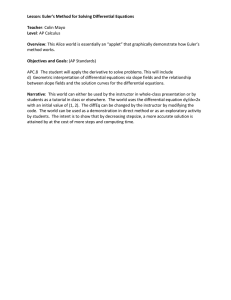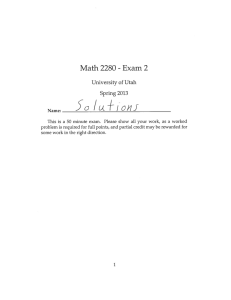Numerical Methods for First Order Equations
advertisement

Numerical Methods for First Order Equations In most of MA2132, we look for analytic solutions of differential equations and systems (analytic is a technical mathematical term, which roughly means a formula for the solution.) For example, we learn techniques for finding the analytic solutions of first order equations which are separable, linear, Bernoulli or exact as well as for higher order linear equations and first order linear systems. However, differential equations which arise in “real” world problems, such as from physics or engineering, rarely have analytic solutions which are easy (or even possible) to find because the world is complex and chaotic, not nice and linear. Even in Calculus, you see differential equations 2 such as y 0 = e−t which do not have solutions which are elementary functions. (Exercise: Look up the definition of elementary function in your Calculus textbook). Therefore, differential equations are frequently solved numerically. As far as we are concerned, this means we will be given a first order IVP y 0 = f (t, y), y(a) = y0 and then be asked to find the approximate value of y(b) at some point b in the domain of y. We concentrate on two classical methods to learn the basic ideas. (1) The Euler Method: Split the interval [a, b] into k subintervals of length h = (b − a)/k, where h is called the stepsize and set t0 = a, t1 = a + h, t2 = a + 2h, . . . , tk = a + kh = b. Then y(t0 ) = y0 and y(tn ) ≈ yn , where yn is computed using the recursive formula yn+1 = yn + hf (tn , yn ). Example: Consider the IVP y 0 = t + y, y(0) = 1. Find the approximate value of y(.3) using the Euler Method with a stepsize of h = .1. Note that f (t, y) = t + y and the initial conditions are t0 = 0 and y0 = 1. t1 = .1, y(.1) ≈ y1 = y0 + hf (t0 , y0 ) = 1 + .1f (0, 1) = 1 + .1(0 + 1) = 1.1 t2 = .2, y(.2) ≈ y2 = y1 + hf (t1 , y1 ) = 1.1 + .1f (.1, 1.1) = 1.1 + .1(.1 + 1.1) = 1.22 t3 = .3, y(.3) ≈ y3 = y2 + hf (t2 , y2 ) = 1.22 + .1f (.2, 1.22) = 1.22 + .1(.2 + 1.22) = 1.362 The Euler method works by approximating the real solution with short straight line segments on the subintervals. The slope of these straight line segments is given by substituting the co-ordinates of its left hand endpoint into f (t, y), because y 0 = f (t, y) is the slope of the real solution. It is very similar to the method of approximating definite integrals with Riemann sums using the Left Rule. The error in the Euler Method is roughly 1 2 proportional to 1/k where k is the number of subintervals used. It also depends on the length of the interval [a, b], since the more steps you use, the more errors you introduce. (2) The Improved Euler Method: Split the interval [a, b] into k subintervals of length h = (b − a)/k, where h is called the stepsize and set t0 = a, t1 = a + h, t2 = a + 2h, . . . , tk = a + kh = b. Then y(t0 ) = y0 and y(tn ) ≈ yn , where yn is computed using the recursive formula (s1 + s2 ) yn+1 = yn + h 2 with s1 = f (tn , yn ) and s2 = f (tn + h, yn + hs1 ) Example: Consider the IVP y 0 = t + y, y(0) = 1. Find the approximate value of y(.3) using the Improved Euler Method with a stepsize of h = .1. Note that f (t, y) = t + y and the initial conditions are t0 = 0 and y0 = 1. In the first step, we have s1 = f (t0 , y0 ) = f (0, 1) = 1 s2 = f (t0 + h, y0 + hs1 ) = f (.1, 1 + .1 · 1) = 1.2 and (s1 + s2 ) 2 (1 + 1.2) = 1 + .1 2 = 1.11 t1 = .1, y(.1) ≈ y1 = y0 + h In the second step, we have s1 = f (t1 , y1 ) = f (.1, 1.11) = 1.21 s2 = f (t1 + h, y1 + hs1 ) = f (.2, 1.1 + .1 · 1.21) = 1.431 and (s1 + s2 ) 2 (1.21 + 1.431) = 1.11 + .1 2 = 1.2421 t2 = .2, y(.2) ≈ y2 = y1 + h In the third step, we have s1 = f (t2 , y2 ) = f (.2, 1.2421) = 1.4421 s2 = f (t2 + h, y2 + hs1 ) = f (.3, 1.2421 + .1 · 1.4421) = 1.6863 and (s1 + s2 ) 2 (1.4421 + 1.6863) = 1.2421 + .1 2 = 1.3985 t3 = .3, y(.3) ≈ y3 = y2 + h Note that the equation y 0 = t + y is linear, so we can find the general solution using an integrating factor. Substituting the initial value y(0) = 1 gives us the particular solution y = −t − 1 + 2et 3 and so the exact values (to four decimal places) are y(.1) = 1.1103 y(.2) = 1.2428 y(.3) = 1.3997. Compare these values with the approximate values obtained using the Euler Method and Improved Euler Method to see how accurate the methods are for this example and stepsize. The Improved Euler Method is also called the Second Order Runge-Kutta Method (or RK2 for short). It is very similar to the Trapezoid Rule for approximating definite integrals, and the error in this method is roughly proportional to 1/k 2 where k is the number of subintervals used. The error also depends on the length of the interval [a, b], since the more steps you use, the more errors you introduce. More Examples: Fill in the details to make sure you understand the methods. (1) y 0 = y + 1, y(1) = 2 and stepsize h = .2. Using the Euler method y(1.2) ≈ y1 = 2.6 y(1.4) ≈ y2 = 3.32 y(1.6) ≈ y2 = 4.184 Using the Improved Euler Method y(1.2) ≈ y1 = 2.66 y(1.4) ≈ y2 = 3.4652 y(1.6) ≈ y2 = 4.4475 The “exact” values (to four decimal places) are y(1.2) = 2.6642 y(1.4) = 3.4775 y(1.6) = 4.4664 2 2 (2) y 0 = e−t , y(0) = 1 and stepsize h = .1. Recall that e−t is an example of a function with no elementary anti-derivative, so the “exact” values can’t really be computed by hand. Using the Euler method y(.1) ≈ y1 = 1.1 y(.2) ≈ y2 = 1.199 y(1) ≈ y10 = 1.7778 Using the Improved Euler Method y(.1) ≈ y1 = 1.0995 y(.2) ≈ y2 = 1.197 y(1) ≈ y10 = 1.7462 4 The “exact” values (to four decimal places) using the Matlab dsolve command are y(.1) = 1.0997 y(.2) = 1.1974 y(1) = 1.7468 There is another classical method called the Fourth Order Runge-Kutta (RK4) method which is based on Simpson’s Rule. It is very accurate with an error roughly proportional to 1/k 4 . It is possible to write this algorithm down and compute values by hand - if you have a lot of time and patience. In practice it is better to use Matlab (or Maple) to compute with this method. Looking at y 0 = t + y, y(0) = 1 with a stepsize h = .1 again, the RK4 method gives y(.1) ≈ y1 = 1.1103 y(.2) ≈ y2 = 1.2428 y(.3) ≈ y3 = 1.3997 so for this example, the RK4 method is accurate to at least 4 decimal places. The Euler and Improved Euler Methods are also available in Matlab (and Maple) - this is described elsewhere on the MA2132 website. All three of these algorithms can be easily adapted to solve first order systems of equations. If you wanted to find numerical solutions of a higher order differential equation, you would probably first convert it into a first order system and then let Matlab do the work for you. Solving differential equations numerically is still an active area of mathematical research. There are many modern methods designed to solve various classes of differential equation efficiently in the real world there has to be a balance between accuracy and computation time (and hence cost). One technique is to use a variable stepsize, if a solution is “changing” rapidly (based on the values of its derivatives) then a small stepsize is needed to ensure sufficient accuracy but if it changes less rapidly elsewhere in its domain then a larger stepsize can be used there (which saves time and hence money). If you type help ode45 or help rk45 in Matlab (depending on the version), you can find implementations and brief descriptions of some modern techniques.




